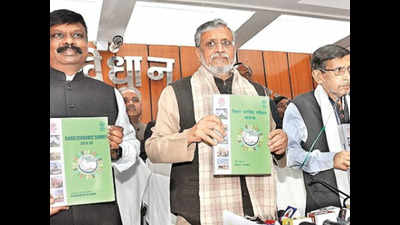- News
- City News
- patna News
- ‘Agriculture and allied sectors major source of employment in Bihar’
Trending
This story is from February 25, 2020
‘Agriculture and allied sectors major source of employment in Bihar’
The state witnessed growth in the agriculture and allied activities, as well as expansion of roads, transport and power sector, that opened new avenues for self-employment and income generating activities for both male and female workers.

Sushil Kumar Modi releases the Bihar Economic Survey 2019-20 in Patna on Monday
PATNA: The state witnessed growth in the agriculture and allied activities, as well as expansion of roads, transport and power sector, that opened new avenues for self-employment and income generating activities for both male and female workers.
The Economic Survey report 2019-20 tabled in the state assembly on Monday has noted that the state’s male workforce found employment mostly in agriculture, forestry and fishing (44.6%), construction (17.1%), wholesale and retail trade, repair of vehicles (12.3%) and manufacturing (9.3%) sectors.
On the other hand, the female workers largely concentrated on two areas for employment and engagement — agriculture, forestry and fishing (53.6%) and education (25.7%).
The report has also pointed out that Rural Self-Employment Training Institute (RSETI) produced skilled workers by training slightly over 1.38 lakh candidates. Of them, 45% were males, 54% females and around 1% transgender. It has also noted that of the total trained persons, 74% were able to get gainful employment in various economic activities.
The physical infrastructure of roads expanded with a massive investment that tripled from Rs5,988 crore in 2012-13 to Rs18,677 crore in 2019-20. Bihar had the credit of becoming the sixth highest state in building additional road length of 1.30 lakh km during 2008-17, and the total paved road in rural areas increased from 35% in 2015 to 75% in 2019.
As a result of this, as many as 11.89 lakh vehicles were registered in the state during 2018-19, in comparison with only 5.53 lakh in 2013-14. The increased registration of vehicles also yielded increased revenue — from Rs835 crore in 2013-14 to Rs2,067 crore in 2018-19, an annual growth rate of 20%.
Similarly, the contribution of the air transport sector to the gross state domestic product (GSDP) increased from Rs31 crore in 2011-12 to Rs252 crore in 2018-19, when as many as 40.61 lakh passengers availed themselves of air travel during 2018-19.
The Economic Survey report 2019-20 tabled in the state assembly on Monday has noted that the state’s male workforce found employment mostly in agriculture, forestry and fishing (44.6%), construction (17.1%), wholesale and retail trade, repair of vehicles (12.3%) and manufacturing (9.3%) sectors.
On the other hand, the female workers largely concentrated on two areas for employment and engagement — agriculture, forestry and fishing (53.6%) and education (25.7%).
The report has also pointed out that Rural Self-Employment Training Institute (RSETI) produced skilled workers by training slightly over 1.38 lakh candidates. Of them, 45% were males, 54% females and around 1% transgender. It has also noted that of the total trained persons, 74% were able to get gainful employment in various economic activities.
The wholesale and retail business across the state has been facilitated by the laying of a network of roads and burgeoning expansion of the transport sector, which registered growth of 11% from 2011-12 up to 2018-19.
The physical infrastructure of roads expanded with a massive investment that tripled from Rs5,988 crore in 2012-13 to Rs18,677 crore in 2019-20. Bihar had the credit of becoming the sixth highest state in building additional road length of 1.30 lakh km during 2008-17, and the total paved road in rural areas increased from 35% in 2015 to 75% in 2019.
As a result of this, as many as 11.89 lakh vehicles were registered in the state during 2018-19, in comparison with only 5.53 lakh in 2013-14. The increased registration of vehicles also yielded increased revenue — from Rs835 crore in 2013-14 to Rs2,067 crore in 2018-19, an annual growth rate of 20%.
Similarly, the contribution of the air transport sector to the gross state domestic product (GSDP) increased from Rs31 crore in 2011-12 to Rs252 crore in 2018-19, when as many as 40.61 lakh passengers availed themselves of air travel during 2018-19.
End of Article
FOLLOW US ON SOCIAL MEDIA










